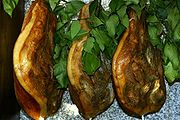
Presunto
Encyclopedia

Dry-cured ham
Dry-cured ham originated as a meat preservation process. Through dry-curing, the ham can be stored for several months. The processing technology is based on traditional knowledge passed from one generation to the other...
from Portugal
Portuguese cuisine
Portuguese cuisine is characterised by rich, filling and full-flavored dishes and is closely related to Mediterranean cuisine. The influence of Portugal's former colonial possessions is also notable, especially in the wide variety of spices used. These spices include piri piri and black pepper, as...
, similar to Spanish
Spain
Spain , officially the Kingdom of Spain languages]] under the European Charter for Regional or Minority Languages. In each of these, Spain's official name is as follows:;;;;;;), is a country and member state of the European Union located in southwestern Europe on the Iberian Peninsula...
jamón
Jamón
Jamón is the Spanish word for ham. In English it refers to certain types of dry-cured ham from Spain. There are two primary types of jamón: Jamón serrano and Jamón ibérico ....
or Italian
Italy
Italy , officially the Italian Republic languages]] under the European Charter for Regional or Minority Languages. In each of these, Italy's official name is as follows:;;;;;;;;), is a unitary parliamentary republic in South-Central Europe. To the north it borders France, Switzerland, Austria and...
prosciutto
Prosciutto
Prosciutto |ham]]) or Parma ham is a dry-cured ham that is usually thinly sliced and served uncooked; this style is called prosciutto crudo in Italian and is distinguished from cooked ham, prosciutto cotto....
crudo.
Among the wide variety of presuntos in Portugal
Portugal
Portugal , officially the Portuguese Republic is a country situated in southwestern Europe on the Iberian Peninsula. Portugal is the westernmost country of Europe, and is bordered by the Atlantic Ocean to the West and South and by Spain to the North and East. The Atlantic archipelagos of the...
, the most famous are presunto from Chaves
Chaves (Portugal)
Chaves is a municipality and municipal seat of an area 10 km south of the Spanish border and 22 km south of Verín in the north of Portugal. The municipality is the second most populous of the district of Vila Real...
, produced in the north of Portugal, and that from the Alentejo, in the south, made from local Alentejano pig
Black Iberian Pig
The Black Iberian pig, also known in Portugal as Alentejano, is a breed, Mediterraneus, of the domestic pig that is indigenous to the Mediterranean area...
s.
A wet-cured
Curing (food preservation)
Curing refers to various food preservation and flavoring processes, especially of meat or fish, by the addition of a combination of salt, nitrates, nitrite or sugar. Many curing processes also involve smoking, the process of flavoring, or cooking...
, light pink ham
Ham
Ham is a cut of meat from the thigh of the hind leg of certain animals, especiallypigs. Nearly all hams sold today are fully cooked or cured.-Etymology:...
called fiambre is more common in everyday meals.
Two varieties of presunto are protected by European law with geographical indications
Protected designation of origin
Protected Geographical Status is a legal framework defined in European Union law to protect the names of regional foods. Protected Designation of Origin , Protected Geographical Indication and Traditional Speciality Guaranteed are distinct regimes of geographical indications within the framework...
.
- Presunto de Barrancos has PDO status.
- Presunto de Barroso has PGI status.

